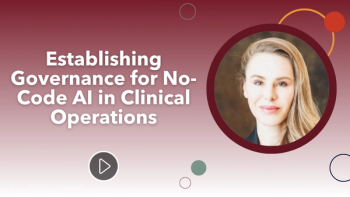
- Applied Clinical Trials-08-01-2011
- Volume 20
- Issue 8
An Idea Whose Time Came
Patient-facing clinical trials are finally implemented a decade later.
A decade ago, Steve Cummings, MD, developed a truly innovative idea: patient-facing clinical trials. And he did one with a nutriceutical product. The trial didn't require an IND, but it went well. However, considering the industry 10 years ago—one only at the beginning of discovering EDC—this untraditional idea never progressed. Then 18-months ago, in early discussions with Pfizer, Cummings realized the idea now could blossom into a true business and founded Mytrus on the anticipation that it was an idea whose time has come.
Anthony Costello, Chief Operating Officer at Mytrus, relates this as background to Mytrus' role in the latest breakthrough in clinical trial process since EDC. With Pfizer at the sponsor-helm, it introduced the "virtual" clinical trial concept in early June. The first-ever randomized clinical trial under an IND is assessing the safety and efficacy of Pfizer's Detrol LA, a treatment for overactive bladder. The study is specifically designed to test the methodology of the virtual trial concept, to determine if it can replicate the results of the previously completed Phase IV Detrol LA trial. This will then validate the patient-centered approach to the trial. The trial itself is called REMOTE, or Research on Electronic Monitoring of OAB Treatment Experience.
REMOTE is stirring a lot of interest and comment. Not only is the trial virtual, it also is truly patient facing. There are four vendors providing the various tools in the chain. Mytrus serves as the single coordinating center for patients, recruitment, the principal investigator, sub-investigator, and the coordinators. Its portal is designed for patients and all the materials they need to read, fill out, or sign including the recruitment process, informed consent, case report forms, and safety data. The other vendor participants in REMOTE are Exco InTouch, providing ePRO via Nokia cell phones; Perceptive Informatics, providing IVRS; and Greenphire, providing subject payments.
In the REMOTE trial, the lead PI is based at the University of California, San Francisco (UCSF), and works with the site staff—employees of Mytrus—that include the sub-PI and the coordinators. Said Costello, "There has always been on clinical trials the thought-leader principal investigator and this will continue into the future. But all other centralized staff are employees of Mytrus." However, not all of the trials follow or will follow the Pfizer model. Costello said the company has other trials with multiple PIs. In fact, there are other differences from the REMOTE trial and how the Mytrus' patient-facing trials will work in the future.
Currently, the company is working on its own ePRO tools, apps for smartphones, and IVRS technology so that it can avoid the endless integration cycle. "We want to give patients a unified interface that has all the tools they need," Costello said. "Whether it's the iPhone or iPad or something else, we want a patient with any mobile device to have the same look and feel and have the access and visibility into the trial."
This visibility into the trial comes with extra effort on the regulatory side. For the REMOTE trial, Costello told Applied Clinical Trials that it involved discussions directly with FDA and approval from multiple IRBs. Western IRB located in Olympia, WA, approved the materials that support all of the states. However, the institutional IRB at UCSF also needed to approve the trials. Historically, institutional IRBs don't have the greatest reputation for speed, but in this instance the approval process went extremely well. "IRBs look at everything that is patient-facing, typically the informed consent, advertisements, and such," explained Costello. "But everything on this trial is patient-facing, so every piece of it had to go through the IRB, which was a substantial increase in volume. But we have not had any significant slow-downs or pushback. In fact, they were quite excited to be working on this and seeing the whole trial for a change."
Mytrus recruits through Google, Facebook, Craigslist, and banner ads on several health information sites such as WebMD and everydayhealth. Mytrus also used hybrid approaches that include partnering with EHR companies or medical foundations to access available patients via e-mail blasts or enewsletters. Another partner website Costello discussed was the WEGO Health site targeted at health activists who may want to help patients find clinical trials.
Currently, enrollment for the trial is ongoing and can be found at
In addition to the much-discussed Pfizer trial, Mytrus has many other studies starting up, including Phase II through Phase IV studies. Even large Phase III oncology studies that require a long-term follow up may convert to the Mytrus model at the end of the study for the follow-up portion.
Mytrus has developed the following videos for patients to learn about the trial:
Articles in this issue
about 14 years ago
Applied Clinical Trials Digital Edition - August 2011, Supplementabout 14 years ago
Applied Clinical Trials Digital Edition - August 2011about 14 years ago
Change the CT Rules, but to What Precisely?about 14 years ago
EFGCP Advocates Change to Consent Processabout 14 years ago
Digital Data, the Semantic Web, and Researchabout 14 years ago
Business and News Update August 2011about 14 years ago
FDA Seeks New Approach to Global Challengesabout 14 years ago
In Pursuit of Enlightenmentabout 14 years ago
Clinical Contracting Efficiencyabout 14 years ago
Latin America Research StatsNewsletter
Stay current in clinical research with Applied Clinical Trials, providing expert insights, regulatory updates, and practical strategies for successful clinical trial design and execution.






.png)



.png)



.png)
.png)
